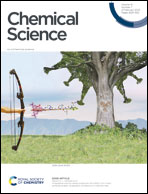Double design of host and guest synergistically reinforces the Na-ion storage of sulfur cathodes†
Abstract
Development of room-temperature sodium–sulfur batteries is significantly hampered by the shuttle effect of soluble intermediates and intrinsically sluggish conversion kinetics. In this work, a double design host and guest strategy (i.e., implantation of a polar V2O3 adsorbent into a carbon substrate and selenium doping of a sulfur guest) is proposed to synergistically reinforce the electrochemical properties of sulfur electrodes in sodium ion storage. The V2O3 adsorbent efficiently immobilizes sulfur species via strong polar–polar interactions, while the selenium dopant improves the electronic conductivity of sulfur cathodes and accelerates the redox conversion of sulfur cathodes. The synergistic effect between the V2O3 adsorbent and selenium dopant is shown to inhibit the shuttle effect and improve the redox kinetics, thus realizing greatly enhanced Na-ion storage properties of sulfur cathodes. The as-designed sulfur cathode delivers a superior rate capability of 663 mA h g−1 at 2.0 A g−1 and demonstrates excellent cyclability of 405 mA h g−1 over 700 cycles at 1.0 A g−1.



 Please wait while we load your content...
Please wait while we load your content...